Ctesiphon
Q192541Ctesiphon (Parthian Tyspwn): ancient city on the Tigris, founded by the Parthians. The city was the capital of the Parthian and the Sasanian empires.
Origin
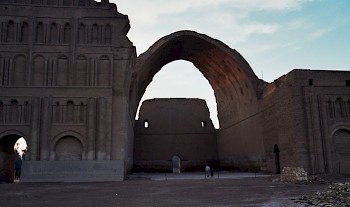
Ctesiphon was built near the site of an older town, Opis, not far from the confluence of Tigris and Diyala. This city was situated on the Royal road, which connected Elam's capital Susa to the Assyrian heartland and - later - the Lydian capital Sardes.
At the end of the fourth century, king Seleucus I Nicator, the successor of Alexander the Great and founder of the Seleucid empire, built Seleucia on the bank opposite Opis. From now on, Opis was a mere suburb of a great, Hellenistic city. Several sources mention that in the first century, Greek and native inhabitants were still recognizable and had institutions of their own. The Parthians, who took over the country in the second century BCE, had hardly any cultural influence.
Parthian residence
However, the Parthians needed a western capital, and therefore, they moved the goverment center away from Seleucia to the eastern bank, and renamed ancient Opis Tyspwn or Ctesiphon. (Alternatively, the city was founded near Opis.) It served as winter residence of the kings after 129 BCE. It is not clear when Ctesiphon became the most important city in the Parthian Empire, but what is reasonably clear is that the spoils of Pacorus' large campaign against the Roman Empire in 41 BCE were invested in the new capital by his successor Phraates IV, which became one of the greatest cities in the ancient world.
The city became even more important after a rebellion of Seleucia against king Vardanes, which ended in 43 CE. The Roman historian Ammianus Marcellinus calls Vardanes the founder of Ctesiphon,note which suggests that he did something to improve the status of this city. A generation later, king Pacorus II is said to have increased its inhabitants and built its walls.note Ctesiphon measured 30 square kilometers (cf. the 13.7 square kilometers of imperial Rome).
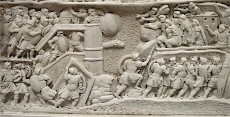
In the second century CE, the large city became the natural target for Roman aggression, because the Romans thought that the capture of the Parthian capital would inevitably result in the fall of the rival empire. In 116, 165, and 198, the emperors Trajan, Lucius Verus (or: to be more precise: his general Avidius Cassius), and Septimius Severus took Seleucia and Ctesiphon. But the Parthian state was organized in a very loose fashion, which gave it a certain resilience.
However, in the long run, the capture by Septimius Severus had a disastrous result. According to a modern estimate, the Romans took away so much gold and silver that they were able to postpone a European economic crisis for three or four decades, and we can imagine the consequences for the Parthians. Their empire was seriously weakened and in 224, the Persian vassal king Ardašir revolted. Two years later, he took Ctesiphon, and this time, it meant the end of Parthia. It also marked the beginning of the second Persian Empire, ruled by the Sasanian kings.
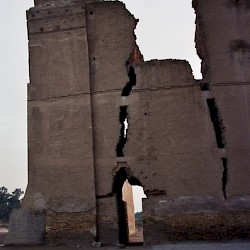 Ctesiphon, Iwan |
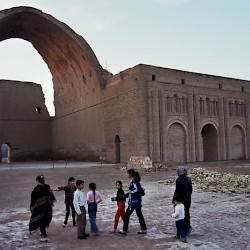 Ctesiphon, Iwan |
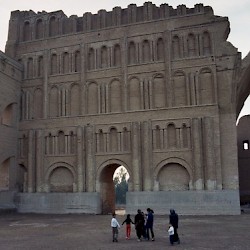 Ctesiphon, Iwan |
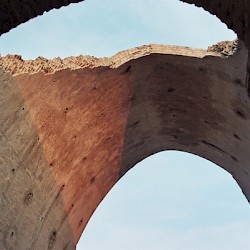 Ctesiphon, Iwan |
Sasanian Ctesiphon
Although Ctesiphon, rebuilt after c.230 as a large, round city, was the capital of the Sasanian empire, Seleucia was not forgotten; it was renamed Veh-Ardašir ("the good city of Ardašir"). The dual city remained a military target for Roman invaders. In 238, the emperor Gordian III wanted to capture Ctesiphon in order to prevent the new Sasanian empire from becoming too powerful, but was murdered before he reached his goal. Odaenathus of Palmyra was more successful in 262, and so was the emperor Carus, who captured the city in 283. But when Julian the Apostate wanted to do the same thing, he was defeated and killed in action (363).

In the fifth century, Ctesiphon became a very important center of Nestorianism, a Christian church that disagrees with the western churches about the nature of Christ. Missionaries from Ctesiphon christianized many people along the Silk Road, e.g., at Rhagae and Maracanda, and in Margiana and Aria. In 635, the first Christians reached China.
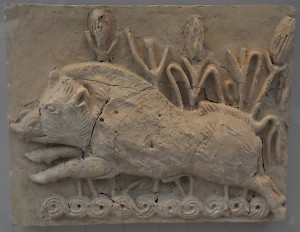
The fifth century also witnessed how the Tigris changed its course: it went through the round city, which was now partly on the same bank as Seleucia. In the eastern half, one could find palaces and the mansions of the rich people. The city probably had no fire temple.
In 540, the Sasanian king Khusrau I conquered the capital of Roman Syria, Antioch. The inhabitants were deported and settled in a new city near Ctesiphon and Veh-Ardašir, which was called "Khusrau's Antioch". There was perhaps a third comparable settlement, and as a consequence, the Arabs started to call the place Al-Mada'in, "the cities".
In 637, the Arabs captured the fourfold city. This was the beginning of their conquest of Mesopotamia. In 762, they built a new government center, 35 kilometers upstream. Its round shape was inspired by Sasanian Ctesiphon, which was gradually eclipsed by the new capital, which was called Baghdad.